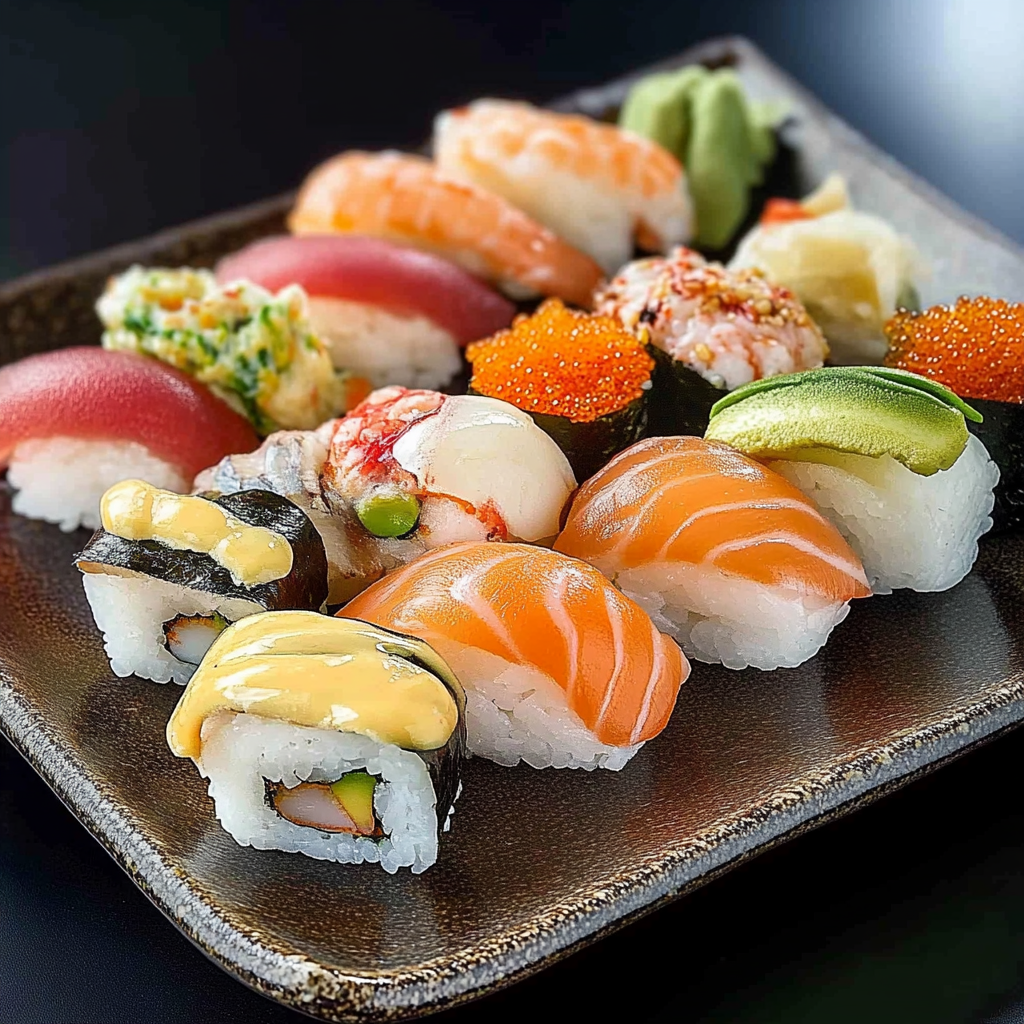There’s something magical about the first bite of traditional Japanese sushi. Picture this: perfectly seasoned rice wrapped around fresh, vibrant fish, with a hint of wasabi and the umami richness of soy sauce dancing on your taste buds. cucumber salad to accompany sushi The aroma wafts through the air, making your mouth water in anticipation. alternative pasta dish Traditional Japanese sushi is not just food; it’s an experience that transcends cultures and brings people together in joyous celebration.

Jump to:
- <strong>Essential Ingredients</strong>
- <strong>Let’s Make it Together</strong>
- <strong>Perfecting the Cooking Process</strong>
- <strong>Add Your Touch</strong>
- <strong>Storing & Reheating</strong>
- <strong>FAQ</strong>
- What type of rice is best for traditional Japanese sushi?
- Can I use cooked seafood in my sushi?
- How long can I store leftover sushi?
- 📖 Recipe Card
I still remember my first sushi-making experience, surrounded by friends who were equally clueless but enthusiastic. We laughed as we fumbled with the bamboo mat and nearly launched sushi rolls across the kitchen. But once we got it right, oh boy! Each roll was a masterpiece that brought us closer together as we shared stories and flavors. Sushi is perfect for family gatherings, cozy date nights, or even an extravagant solo dinner when you want to treat yourself to something special!
Why You'll Love This Recipe
- This traditional Japanese sushi recipe makes meal prep an enjoyable adventure
- You can easily customize ingredients based on personal taste or dietary preferences
- The visual appeal of colorful rolls makes any gathering feel festive and special
- Perfect for sharing with friends or enjoying as a delightful solo dish!
I’ll never forget the laughter that erupted when one of my friends accidentally created a “sushi explosion.” Instead of rolling it tightly, he ended up with more rice on his shirt than on his plate! It’s those little moments that make cooking together so memorable.
Essential Ingredients
Here’s what you’ll need to make this delicious dish:
- Sushi Rice: Short-grain rice is essential for achieving that perfect sticky texture needed for sushi.
- Rice Vinegar: Use seasoned rice vinegar to enhance the flavor of the rice and add a hint of sweetness.
- Nori Sheets: These seaweed sheets provide structure and flavor; look for high-quality nori for best results.
- Fresh Fish: Opt for sashimi-grade fish like tuna or salmon; freshness is key to great-tasting sushi.
- Vegetables: Cucumber, avocado, or carrots add crunch and color; feel free to mix according to your preferences.
For the Dipping Sauce:
- Soy Sauce: Choose low-sodium soy sauce to control the saltiness while dipping your delightful rolls.
- Wasabi: A small dab adds a spicy kick; adjust according to your heat tolerance!
- Pickled Ginger: Use as a palate cleanser between different types of sushi; it adds a refreshing zing.
The full ingredients list, including measurements, is provided in the recipe card directly below.

Let’s Make it Together
Gather your ingredients and let’s embark on this delicious journey into traditional Japanese sushi-making. protein-packed roll-up ideas.
Prepare the Sushi Rice: Rinse 2 cups of sushi rice under cold water until clear to remove excess starch. Cook according to package instructions until fluffy.
Add Seasoning to Rice: Once cooked, transfer rice into a large bowl and mix gently with 1/4 cup seasoned rice vinegar while it’s still warm. Allow it to cool slightly.
Prepare Your Fillings: While waiting for the rice to cool, slice fresh fish into thin strips and julienne vegetables like cucumber and carrots. Arrange them neatly on a platter.
Assemble Sushi Rolls: Place a sheet of nori shiny side down on a bamboo mat. Wet your hands and spread about 1 cup of rice evenly over nori, leaving 1 inch at the top edge.
Add Fillings and Roll It Up!: Layer fish and vegetables horizontally across the center of the rice-covered nori. Using the mat, roll tightly away from you while pressing gently to shape it.
Slice & Serve!: With a sharp knife dipped in water (to prevent sticking), slice each roll into 6-8 pieces. Serve with soy sauce, wasabi, and pickled ginger. Enjoy with friends or savor alone!
Now you’re all set to impress your family or just treat yourself! Traditional Japanese sushi is not only delicious but also fun to make—especially when laughter fills the kitchen along with those aromatic flavors! For more inspiration, check out this garlic butter green beans recipe.
You Must Know
- When making traditional Japanese sushi, using fresh ingredients is key for flavor
- Mastering the rice texture will elevate your sushi game
- Don’t forget to experiment with fillings to create your signature roll!
Perfecting the Cooking Process
Begin by rinsing the rice thoroughly until the water runs clear. Cook it perfectly, then let it cool before shaping. This order ensures optimal texture and flavor.
Add Your Touch
Feel free to swap out traditional fillings like tuna or cucumber for avocado or grilled veggies. grilled vegetable side dish Adding a dash of sesame oil can also enhance flavors.
Storing & Reheating
To maintain quality, store leftover sushi in an airtight container in the fridge. Enjoy it cold; reheating is not recommended as it alters texture.
Chef's Helpful Tips
- Always use sushi-grade fish for safety and flavor; it makes all the difference
- Invest in a bamboo mat to shape rolls easily and uniformly
- Remember, practice makes perfect when it comes to rolling techniques!
Cooking sushi reminds me of my first attempt—my friends dubbed them “deconstructed sushi” after I fumbled the rolls. They tasted great, though, and laughter filled our kitchen.
FAQ
What type of rice is best for traditional Japanese sushi?
Short-grain sushi rice provides the ideal sticky texture needed for proper rolling.
Can I use cooked seafood in my sushi?
Absolutely! Cooked shrimp or crab works well and adds delicious flavor to your rolls.
How long can I store leftover sushi?
It’s best to eat leftover sushi within 24 hours for optimal freshness and taste.
Did You Enjoy Making This Recipe? Please rate this recipe with ⭐⭐⭐⭐⭐ or leave a comment.
📖 Recipe Card
Print
Delight in Traditional Japanese Sushi
- Total Time: 50 minutes
- Yield: Approximately 4 servings (4 rolls) 1x
Description
Experience the joy of making traditional Japanese sushi at home! This delightful recipe combines perfectly seasoned sushi rice with fresh fish and vibrant vegetables, creating a culinary adventure that’s as fun to prepare as it is to eat. Perfect for gatherings or a cozy night in, this sushi will impress friends and family alike.
Ingredients
- 2 cups short-grain sushi rice
- 1/4 cup seasoned rice vinegar
- 4 sheets nori
- 8 ounces sashimi-grade fish (tuna or salmon)
- 1 cucumber, julienned
- 1 avocado, sliced
- Low-sodium soy sauce for dipping
- Wasabi to taste
- Pickled ginger for serving
Instructions
- Rinse sushi rice under cold water until clear. Cook according to package instructions and let cool.
- In a large bowl, mix warm rice with seasoned rice vinegar gently and let it cool slightly.
- Prepare fillings by slicing fish into thin strips and julienning vegetables.
- Lay a sheet of nori on a bamboo mat; wet hands and spread about 1 cup of rice evenly over the nori, leaving 1 inch at the top.
- Place fish and vegetables across the center of the rice-covered nori. Roll tightly using the mat, pressing gently to shape.
- With a wet knife, slice each roll into 6-8 pieces. Serve with soy sauce, wasabi, and pickled ginger.
- Prep Time: 30 minutes
- Cook Time: 20 minutes
- Category: Main
- Method: Rolling
- Cuisine: Japanese
Nutrition
- Serving Size: 1 roll (approximately 150g)
- Calories: 250
- Sugar: 0g
- Sodium: 200mg
- Fat: 8g
- Saturated Fat: 1g
- Unsaturated Fat: 7g
- Trans Fat: 0g
- Carbohydrates: 36g
- Fiber: 3g
- Protein: 10g
- Cholesterol: 30mg





